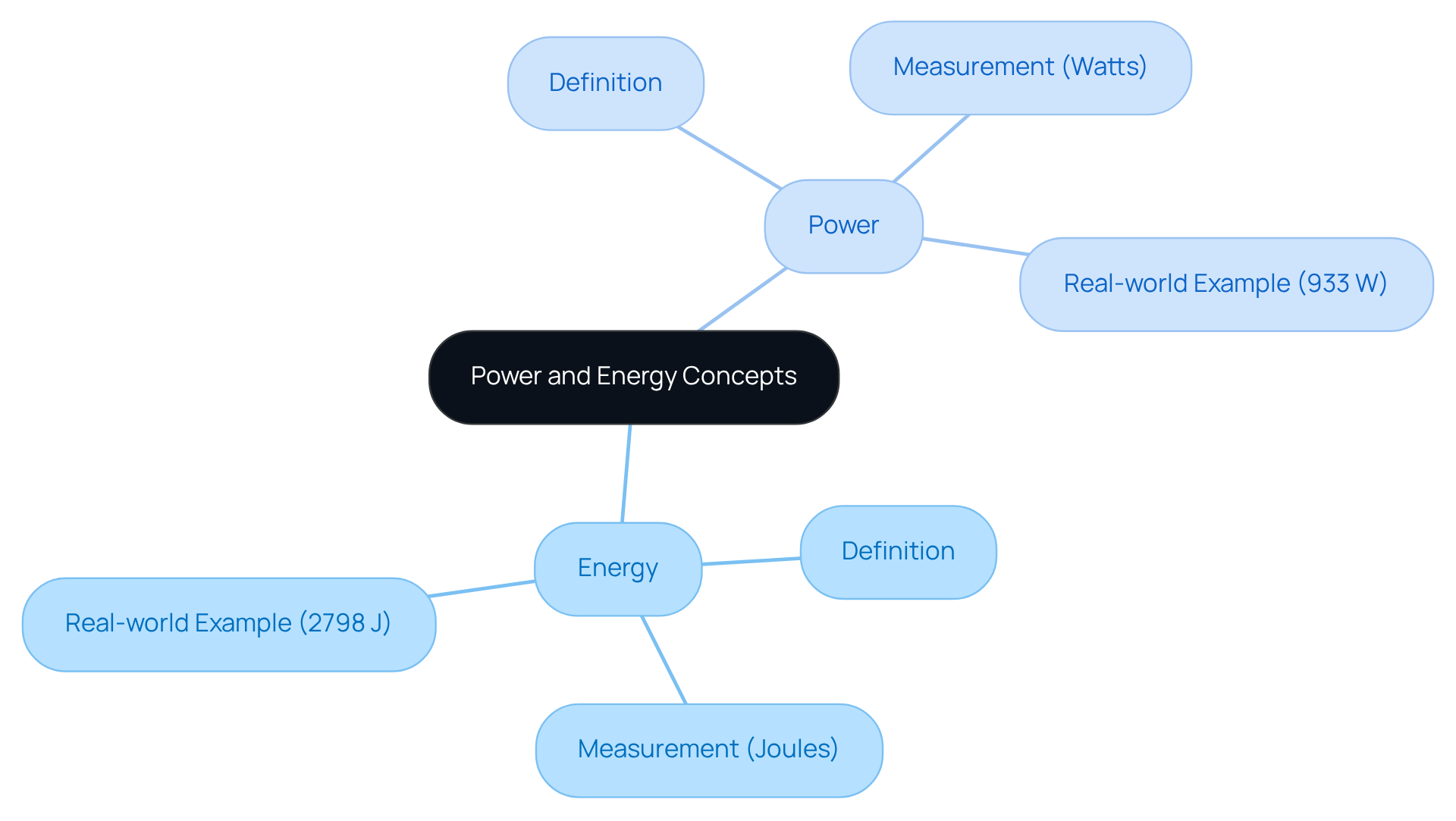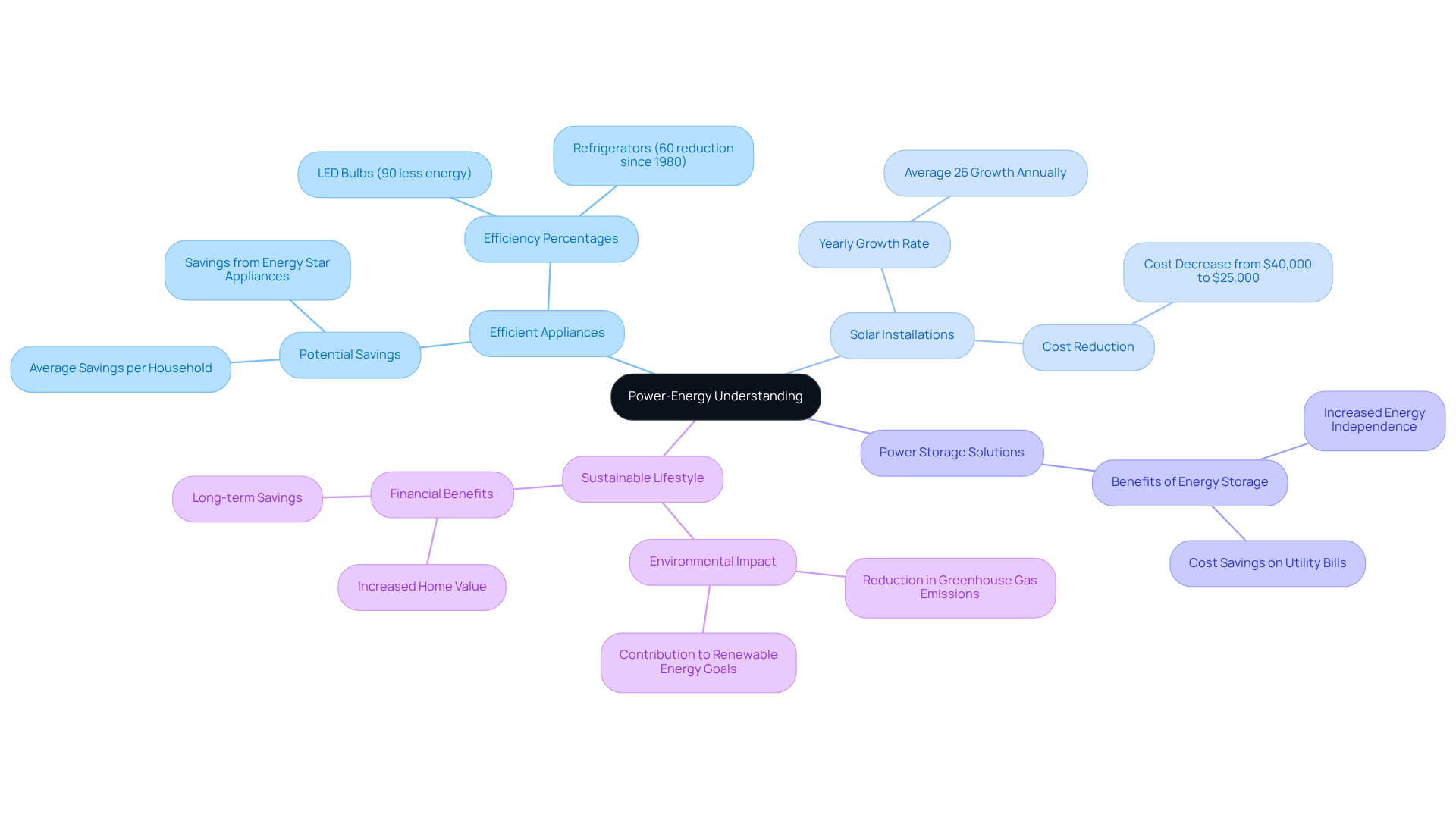Overview
In today’s world, many homeowners are understandably concerned about rising energy bills. The article highlights a crucial distinction that can significantly impact your energy consumption and costs: the difference between power and energy. Energy is the capacity to do work, while power is the rate at which that work is accomplished. By grasping this difference, you can make informed decisions about renewable energy systems that not only lead to financial savings but also enhance your energy efficiency.
It’s common to feel overwhelmed by the complexities of energy management. However, understanding these concepts empowers you to take charge of your energy use. Imagine harnessing the sun’s power through solar energy—this not only reduces your reliance on traditional energy sources but also fosters a sense of independence. Together, we can explore sustainable solutions that align with your values and contribute to a greener future.
As you consider your energy habits, reflect on how these insights can guide you towards a more sustainable lifestyle. The journey towards energy independence is within reach, and we are here to support you every step of the way. Let’s work towards a future where you feel confident in your energy choices and enjoy the benefits of reduced costs and increased efficiency.
Introduction
Understanding the distinction between power and energy is essential for homeowners who are concerned about sustainability and managing their energy bills. We understand that navigating these concepts can feel overwhelming, yet grasping the difference can empower you to make informed decisions. While energy represents the total capacity to perform work, power measures the rate at which that work is done. This fundamental understanding creates a crucial framework for effectively managing energy consumption.
As eco-conscious homeowners, you are likely seeking ways to optimize your energy use and reduce utility costs. It’s common to feel uncertain about how to achieve these goals. However, a deeper understanding of power and energy can illuminate the path towards smarter choices in renewable energy solutions. By embracing solar energy, for instance, you can not only lower your bills but also move towards energy independence.
Together, let’s explore how these concepts can lead to meaningful changes in your home. By making informed decisions, you can take significant steps towards a more sustainable future. Your journey towards energy efficiency and independence begins with understanding these distinctions, and we are here to support you every step of the way.
Define Power and Energy: Core Concepts
Power and vitality are fundamental concepts in physics and electrical engineering that, while often confused, are distinctly different. Energy is defined as the capacity to do work, measured in joules (J). It represents the total amount of work that can be performed by a force. For example, the effort needed to lift one typical passenger is roughly 2798 joules, demonstrating how power is measured in real-world situations. Power, however, is the rate at which work is transferred or converted, measured in watts (W), where one watt equals one joule per second. For instance, an escalator moving 20 passengers every minute requires about 933 watts of power to function efficiently.
We understand that managing energy bills can be a concern for many homeowners. Grasping these definitions is vital for property owners seeking to enhance their power energy difference and make knowledgeable choices regarding their power systems, especially when evaluating renewable energy options. In California, the average household uses approximately 6,000 kilowatt-hours each year. This highlights the significance of understanding these concepts to manage consumption efficiently.
By comprehending strength and vitality, property owners can make informed decisions about photovoltaic setups and storage alternatives, ultimately decreasing expenses and improving autonomy. Together, we can explore how these solutions can lead to energy independence. With Powercore Electric, eco-conscious homeowners can access innovative renewable solutions that not only promote sustainability but also provide financial savings and independence.
Are you ready to take the next step? Contact us today for a complimentary customized estimate and discover how you can utilize the benefits of solar technology for your home.
Differentiate Power and Energy: Key Distinctions
Understanding the difference between strength and vitality can feel overwhelming, especially when considering your energy bills. It’s essential to recognize that the power energy difference quantifies the total work that can be performed, while strength measures the rate at which that work is accomplished. For example, a photovoltaic panel system might produce 300 kilowatt-hours (kWh) of power over a month, but its capacity rating could be 5 kilowatts (kW). This rating signifies the highest power output at any specific moment, and understanding the power energy difference is crucial for homeowners assessing their power requirements. By grasping these concepts, you can choose appropriate photovoltaic solutions, particularly under the 200% rule, which allows for expanded panel installation to optimize the power energy difference in power generation.
In California, the typical output rating of residential photovoltaic systems generally varies from 5 to 10 kW, aligning with the consumption needs of most households. Property owners often evaluate their electricity demands according to these ratings, ensuring their installations can efficiently satisfy their usage requirements. For instance, if your household uses approximately 600 kWh each month, you would benefit from a system with a capacity that can reliably produce electricity to meet your consumption, especially during high-demand periods. We understand that navigating these choices can be challenging, but you’re not alone in this journey.
Furthermore, both ratings and the power energy difference influence the performance of photovoltaic modules during generation. While a higher power energy difference may indicate superior performance, it is the overall output generated over time that ultimately affects your utility costs. Specialists in renewable sources highlight the importance of understanding these metrics, as the power energy difference empowers property owners to maximize their investments and achieve sustained savings. Based on industry statistics, installations of photovoltaic systems can lower household utility costs by 20-50%, making them a financially wise option for environmentally conscious residents. When assessing service providers for solar power, consider the overall value provided, including installation quality and customer assistance. This ensures you make the best choice for your power needs.
Moreover, findings from case studies illustrate how property owners have effectively gained advantages from domestic photovoltaic systems under the 200% rule. These examples emphasize the potential for enhanced power production and savings. Together, we can explore how these solutions can lead to a brighter, more sustainable future for you and your family.
Explore the Importance of Power-Energy Understanding
Understanding the power energy difference between power and electricity is crucial for homeowners concerned about rising utility bills and their impact on our planet. By understanding the power energy difference in how power is consumed and the rate at which it is utilized, you can make informed choices about efficient appliances, solar installations, and power storage solutions that truly benefit your household. Imagine the savings—many efficient appliances can cut power usage by up to 80% compared to older models, translating to hundreds of dollars saved each year on your utility expenses. This knowledge empowers you to enhance your renewable systems by understanding the power energy difference, ensuring you get the most out of your investments in sustainable resources.
We understand that the journey toward sustainability can feel overwhelming, but recent trends show a positive shift. Solar installations have increased significantly, averaging 26% growth each year over the past decade. This reflects a broader movement towards sustainable power practices that not only help the environment but also support your financial well-being. Ultimately, grasping these concepts fosters a more sustainable lifestyle while contributing to personal savings and environmental benefits. Together, we can embrace energy efficiency and make a meaningful impact. If you’re ready to explore these options further, let’s connect and discuss how we can support you on this journey.
Conclusion
We understand that managing energy bills can be a significant concern for eco-conscious homeowners. Recognizing the power energy difference is essential for those looking to optimize their consumption and reduce utility costs. By distinguishing between power and energy, you can make informed decisions about renewable energy systems that truly align with your specific needs and consumption patterns.
Throughout this article, we shared key insights regarding the definitions and measurements of power and energy, emphasizing their impact on household efficiency. It’s common to feel overwhelmed by the complexities of energy systems, but understanding photovoltaic systems, the significance of capacity ratings, and the potential for substantial savings on your utility bills through effective energy management can empower you. These insights not only help you navigate these complexities but also enhance your investments in sustainability.
Ultimately, embracing the knowledge of power and energy not only contributes to your personal savings but also fosters a broader commitment to environmental sustainability. As trends in solar installations continue to grow, we encourage you to take proactive steps toward energy independence. By exploring renewable options and understanding the nuances of energy consumption, together we can work towards a brighter and more sustainable future for every household. Let’s take this journey together, ensuring that your home not only saves money but also contributes positively to our planet.





